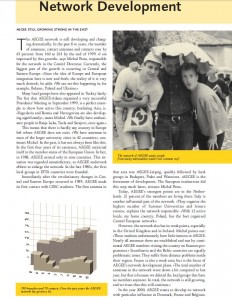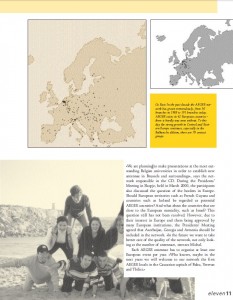AEGEE still growing strong in the East
The AEGEE network is still developing and changing dramatically. In the past five years, the number of antennae, contact antennae and contacts rose by 63 percent: from 160 to 261 by the end of 1999. “I am impressed by this growth,” says Michal Pesta, responsible for the network in the Comité Directeur. Currently, the biggest part of the growth is occurring in Central and Eastern Europe. “Since the idea of Europe and European integration here is new and fresh, the reality of it is very much desired,” he adds. “We can see this happening in, for example, Belarus, Poland and Ukraine.”
Many local groups have also appeared in Turkey lately. The fact that AEGEE-Adana organised a very successful Presidents’ Meeting in September 1999, is a perfect example to show how active this country, bordering Asia, is. “Yugoslavia and Bosnia and Herzegovina are also developing significantly,” states Michal. “We finally have enthusiastic people in Banja Luka, Tuzla and Sarajevo, once again.”
This means that there is hardly any country in Europe left where AEGEE does not exist. “We have antennae in most of the larger university cities in 42 countries,” continues Michal. In the past, it has not always been like this. In the first four years of its existence, AEGEE restricted itself to the member states of the European Union. In fact, in 1988, AEGEE existed only in nine countries. This situation was regarded unsatisfactory, so AEGEE undertook efforts to enlarge the network. In the late 1980s, first local groups in EFTA countries were founded.
Immediately after the revolutionary changes in Central and Eastern Europe occurred in 1989, AEGEE made its first contact with CEEC students. The first antenna in that area was AEGEE-Leipzig, quickly followed by local groups in Budapest, Praha and Warszawa. “AEGEE is the forerunner of development. The European institutions did this step much later,” stresses Michal Pesta.
Today, AEGEE’s strongest points are in the Netherlands. 21 percent of its members are living there. Italy is another influential part of the network. “They organise the highest number of Summer Universities and leisure events,” explains the network responsible. “With 12 active locals, my home country, Poland, has the best organised Central European network.”
However, the network also has its weak points, especially in the United Kingdom and in Ireland. Michal points out: “These students unfortunately have little interest in AEGEE. Nearly all antennae there are established and run by continental AEGEE members visiting the country on Erasmus programmes.” Scandinavia and the Baltic countries are equally problematic zones. They suffer from distance problems inside their region. France is also a weak area, but it is the focus of AEGEE’s network development plans. “The total number of antennae in the network went down a bit compared to last year, but that is because we deleted the local groups that have no members anymore. In total, the network is still growing, and we trust that this will continue.”
In the year 2000, AEGEE wants to develop its network with particular influence in Denmark, France and Belgium. “We are planning to make presentations at the most outstanding Belgian universities in order to establish new antennae in Brussels and surroundings,” says the network responsible in the CD. During the Presidents’ Meeting in Skopje, held in March 2000, the participants also discussed the question of the borders in Europe. Should European territories such as French Guyana and countries such as Iceland be regarded as potential AEGEE countries? And what about the countries that are close to the European mentality, such as Israel? This question still has not been resolved. However, due to their interest in Europe and them being approved by many European institutions, the Presidents’ Meeting agreed that Azerbaijan, Georgia and Armenia should be included in the network. “In the future we want to take better care of the quality of the network, not only looking at the number of antennae,” stresses Michal.
Each AEGEE antenna has to organise at least one European event per year. “Who knows, maybe in the next years we will welcome to our network the first AEGEE locals in the Caucasian capitals of Baku, Yerevan and Tbilisi.”
Written by Key To Europe 1999-2000 Team
Originally published in Key To Europe 1999-2000



